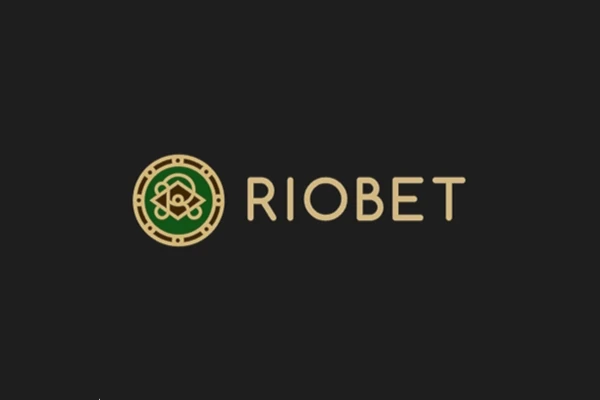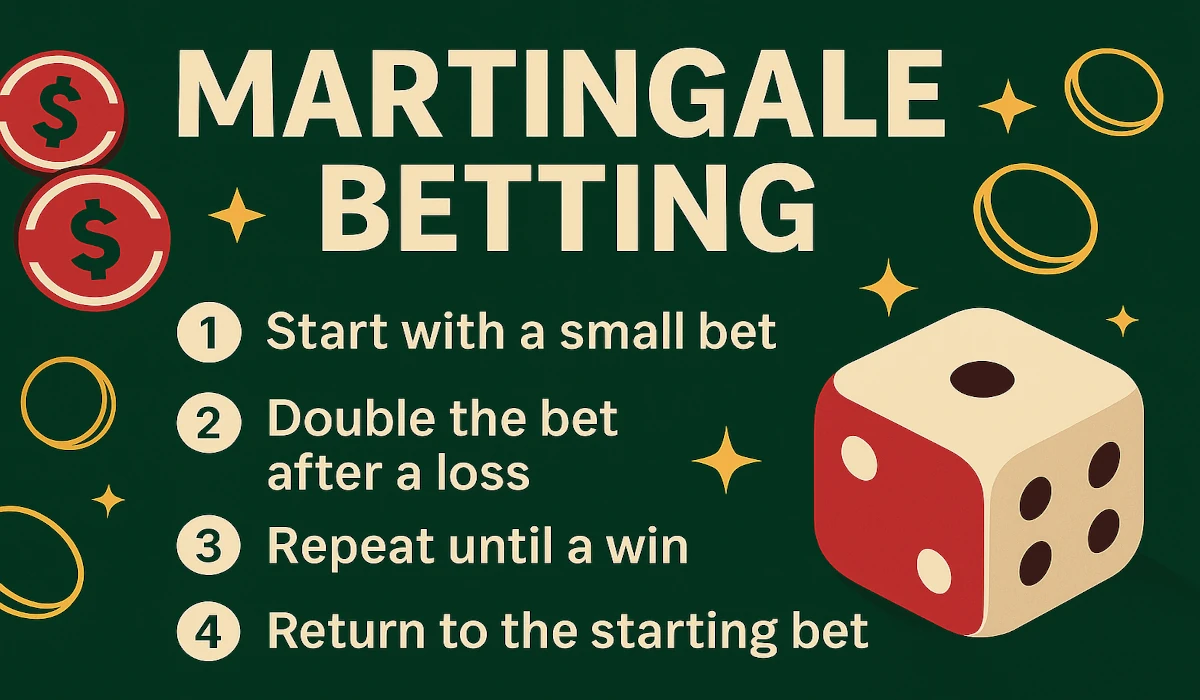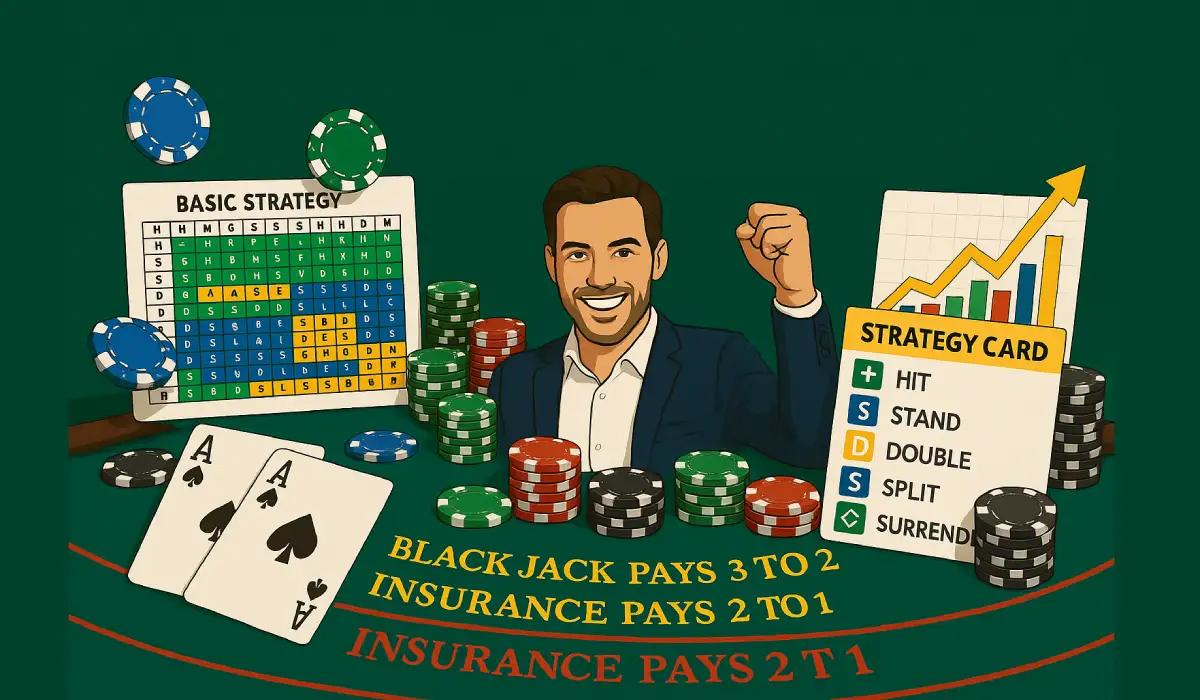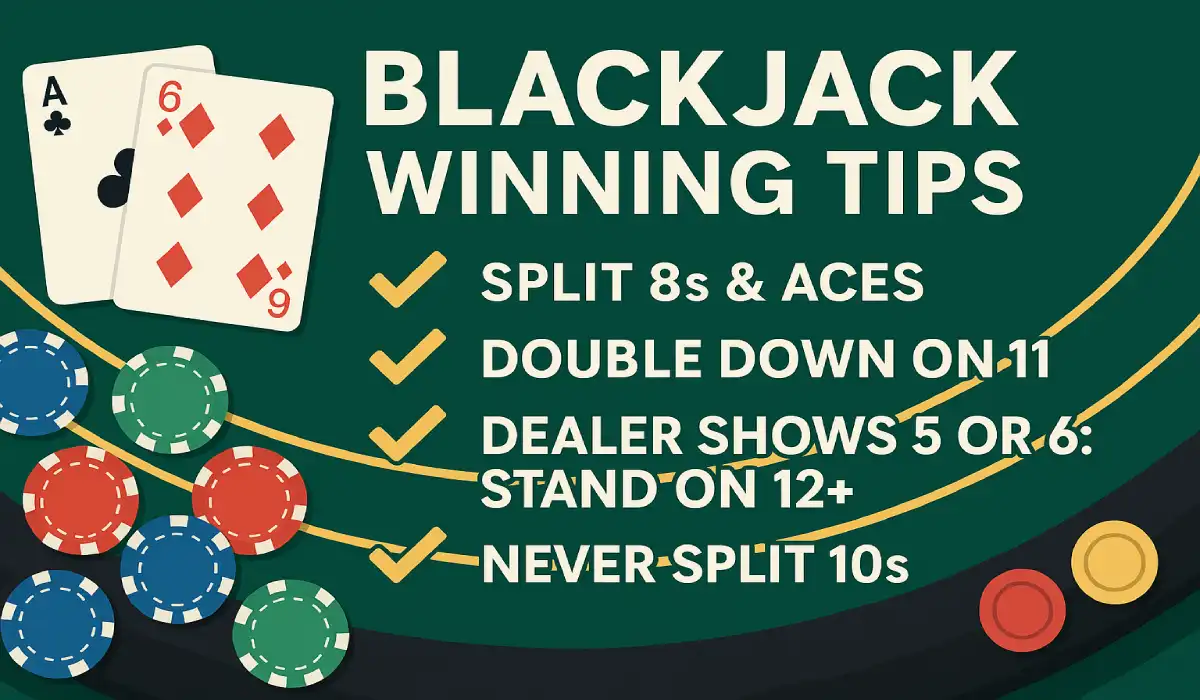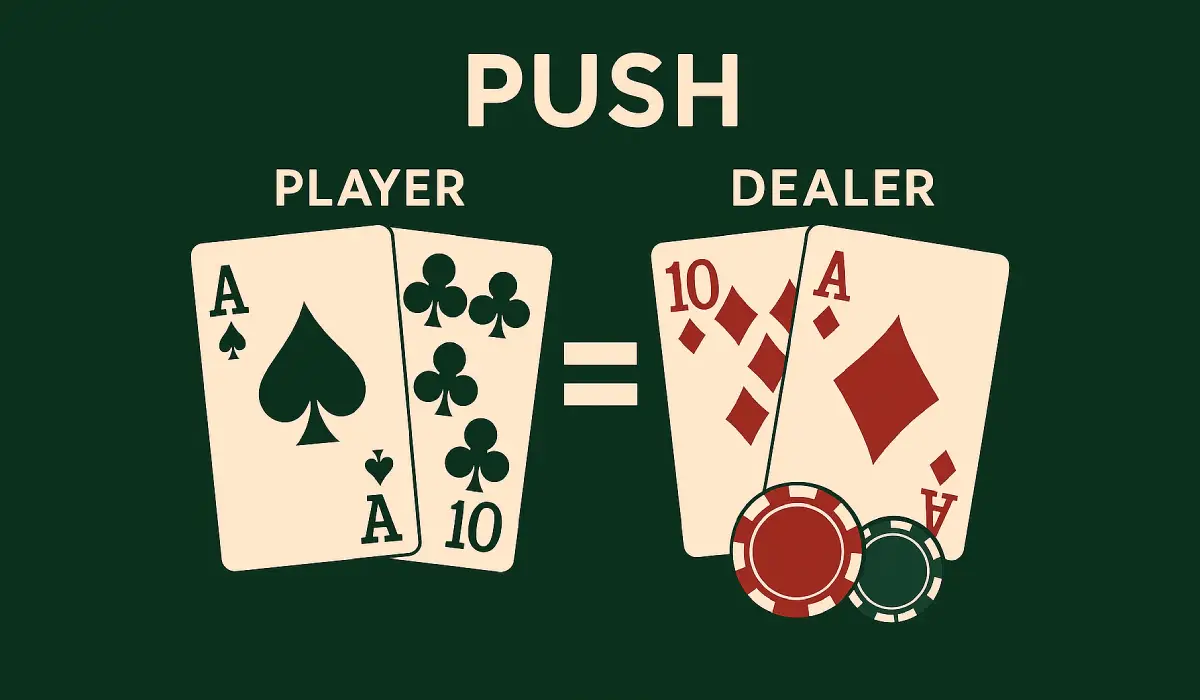
19 Jun 2025
What is a Push in Blackjack? Rules and Implications
🗝️ Key Takeaways
- A push in Blackjack appears when both the player and dealer have hands of equal value, typically between 17 and 21, resulting in the return of the original bet without any winnings or losses.
- Some common situations are 20 vs. 20 or both being dealt a blackjack, which tends to drive home the tie possibilities of the game.
- Knowing that a push doesn’t increase or decrease your bankroll is important for strategic thinking and preserving your bankroll over many rounds.
- Players should embrace pushes as neutral game breakers that not only disrupt game momentum but offer a psychological balm to outright losses.
- Knowing the casino rules, such as variations like Push 22, is important, as they can greatly affect strategy and expected value.
- Taking into account the likelihood and strategy of a push in your blackjack strategy can give you a better idea of when to bet and when it’s more prudent to hold back.
Push in Blackjack means that the player and the dealer tie, so you don’t win or lose that bet. Here, the game returns your original bet, and the cash remains even for both parties.
Many blackjack beginners ask what a push is, and the push rule is essential to good blackjack etiquette. Casino rules don’t change a whole lot for pushes, but some tables display the tie in different ways, such as chips still in place or a straightforward declaration.
To understand why pushes are important, the following explain how ties impact bets and gameplay.
🎯 Understanding a Push in Blackjack
In Blackjack, when the player and the dealer have the same valued hand — usually a score between 17 and 21 — it is called a push. Here the round ends in a tie, and the player’s wager is refunded rather than winning or losing.
A push can additionally occur if both are dealt a natural blackjack (an Ace and 10 value card) from the outset. These are mostly in-hand outcomes with 18, 19, 20 or Blackjack.
A push happens approximately 8.5% of the time in each hand, yet a double natural blackjack is highly unlikely, happening only once in 429 hands. Certain blackjack variations incorporate special rules — like “push 22” — but the traditional games don’t.
Common scenarios that lead to a push include:
- The player and dealer have 20 (King + Queen vs. Jack + 10).
- Both have 19 (10 + 9).
- They both get a blackjack (A+K vs. A+J).
- Both add up to 18, such as 10 + 8 vs. 9 + 9.
- Both hit 21 with multiple cards, e.g., 7 + 7 + 7 vs 9 + 6 + 6.
1. The Tie
In Blackjack, a push occurs when you and the dealer tie with the same hand value. That is, as a newcomer to the game might be surprised to hear, that neither side wins or loses.
Pushes in Blackjack are resolved by giving the player back their initial bet. There is no additional payout and no lost money.
Typical hand values that result in a push are 18, 19, 20, and 21. Say both have 19, the round pushes).
Identifying these tie results is important for players crafting viable blackjack strategies because repeated pushes can affect return potential in the long run.
2. The Bet
In the case of a push, the casino refunds the player’s original wager - no wins or losses.
This “money back” outcome can affect a player’s betting strategy. Understanding pushes aids in bankroll management, as these ties do not alter the player’s bankroll.
By following pushes, they can plan bets and not overreach in up-and-down sessions.
3. The Outcome
A push is a wash, neither a win or a loss. It’s not like a definitive victory, whereby the player is paid out, or a defeat, where the bet is seized.
Pushes define the blackjack experience. They can aggravate players who only pushed on strong hands, such as 21, but provide some comfort following wild bets. Accounting for pushes in your long-term strategy is smart.
Recognizing that roughly 8.5% of hands conclude this way, players should evaluate their achievement relative to total wagers, not just victories.
4. The Exception
Pushes can occur even on double bets if both hands push. Split pairs, and you may have varying results–one split hand may push, and the other wins or loses.
For example, splitting eights against a dealer’s nine can have one hand push 18, and the other lose with 17. Side bets are never pushed, they win or lose.
💸 Impact on Your Wager

Push in blackjack means your bet is returned when you tie the dealer, either with a blackjack or a 17-21 that match. This outcome neither wins nor loses, leaving your bankroll intact.
Roughly 8.5% of rounds push. Factoring shove into your decisions is key for clever, well-rounded play.
💰 Bankroll Stability
1. When a push occurs, your initial bet is returned to you, not shaking your bankroll. This provides a mental lift, as it doesn’t register as a loss — it registers as neutral, which can be its own kind of relief in extended sessions.
Say you wager €20 and push – well, you get those €20 right back to play another hand.
2. The security feeling makes a difference, particularly over a few rounds. For a lot of players, pushes allow them to reset mentally, instead of hunting losses. This mental pause helps control emotion and maintain concentration for the next hand.
Viewing pushes as a standard component of the game, rather than as blowbacks, aid in discipline and long-term play.
➖ No Profit
A push is zero profit. Even if you hit a natural blackjack but the dealer does too, you receive your wager back, not the standard payout.
This can be frustrating, particularly if you were anticipating a victory. Eventually, players realize that pushes don’t actually add to or take away from their winnings, so they should adjust their expectations accordingly.
In certain blackjack variations, such as those employing the 22-push rule, pushes can occur more often, and the house may have a bigger advantage — as high as 6.91%. As players, we want to play in a way that helps us increase win percentages, not count on pushes.
✅ No Loss
Pushes save you from dropping your bet on a round. For many people, this can take the edge off during cold streaks.
When losses stack, a push gives you a breather and an opportunity to recalibrate. It’s best to treat pushes as a pause, not failure, and leverage them to strategize your next step.
🧠 The Psychology of a Push

A push in blackjack is when the player and dealer end a round with the same hand value—typically between 17 and 21, or both with blackjack. It’s a push, not a win—against-the-player’s bet is returned.
Although this result appears to be neutral, the psychology is more complex.
- Relief from not losing money, after a risky hand particularly.
- Pride in losing a win with a strong hand.
- Nonchalance or resignation, playing it as a matter of course.
- Frustration if a push breaks a winning streak.
- Motivation to adjust strategy for the next hand.
- Confidence boost if a push comes after several losses.
- Anxiety from repeated pushes, questioning one’s decisions.
⚖️ Relief vs. Disappointment
Other players feel relief when their hand pushes. Not losing is more important than losing, particularly if they went for it or played hard.
For instance, hitting a hard 18 against a dealer’s strong card may seem warranted when it results in a push.
Disappointment can leave a residue, as well. Most view a push as throwing away a strong hand, particularly if they were just about to win.
Such can be the case for a player who pulls a 20 just to push against the dealer’s 20. Handling these feelings is key.
Mood swings lose attention, which leads to bad decisions. Cultivating the emotional resilience—embracing that pushes occur—allows players to maintain a cooler head and place wiser bets.
♟️ Strategic Mindset
Approaching a push as an opportunity to rethink strategy pays off. Pushes prove that the game can turn in minor ways, not just triumphs or defeats.
Identifying these urges allows players to resist knee-jerk responses, such as swelling bets in anger or shrinking them out of anxiety. The players who incorporate pushes into their strategy can adapt with more flexibility.
For instance, if pushes occur frequently because of the rules of the game, modifying your play style—say, when to hit or stand—can assist. Flexibility is essential.
When you see pushes as feedback, not setbacks, it bolsters your long term decision-making.
⚡ Momentum Breaker
A push can disrupt the flow of a session. Following a streak of decisive hands, a tie can seem like a breather.
This stall in momentum can cause self-doubt or impatience, driving players to pursue wins or recoup losses too fast.
Just as important is staying focused after a push. Rather than viewing the event as a blow, players should use it as an opportunity to recalibrate.
To get unstuck, others might go over their last several hands, check their mood, or double-check their betting strategy. There are, of course, practical tactics—such as a quick break—that can help clear the mind and avoid impulsive maneuvers.
🏆 Skillful Play
Mastering the psychology of pushes makes you play better. Emotional discipline maintains strategic acuity.
Adaptability turns non-results into lessons. Players get better by being cool and collected.
📋 Push Rule Variations
Push rules in blackjack determine what occurs when the player and dealer tie with a hand total — typically between 17 and 21. These can vary by casino and by game, influencing your odds as well as your returns.
Understanding these variations on push results and rule sets is essential for anyone looking to play savvy, tweak their strategy, or just sidestep an unexpected round at the table. Here’s a quick comparison of push rules found in casinos worldwide:
| Casino/Game Variant | Push Outcome | Notes |
| Standard Blackjack | Bet returned (no win/loss) | Most common worldwide |
| Push 22 Rule (Dealer 22) | Tie if dealer has 22 | Popular in some "Free Bet" |
| European No Hole Card | Bet lost if dealer blackjack | Can impact push frequency |
| 21 vs. Dealer Blackjack | Push, not player win | Some casinos adopt this |
| Player loses on all ties | Player loses push | Rare, found in some side bets |
📜 Standard Rules
Push in blackjack indicates the player’s initial bet is returned on a tied player/dealer game, typically with hands totaling 17-21. This result is evident in the majority of casinos and standard game variations, such as American and European blackjack.
Whether it’s a push is contingent on both the rules and the player. For example, standing on a soft 17 or hitting a dealer’s low card can marginally impact your push count.
Understanding how pushes operate in your game is key. If you multi-table or casino hop, just verify the basic rules posted near the table or in the casino’s rules.
Depending on the default push rule, it allows you to keep your bets and your expectations in check, so you only wager what you know and can afford.
♠️ Push 22
Certain casinos implement the ‘Push 22’ rule, primarily seen in Free Bet Blackjack. If the dealer reaches 22, all remaining player hands push (except blackjacks, which still win).
This rule changes the flow and strategy: hands that would normally win now only return your bet when the dealer hits 22.
Not all casinos apply this rule, so be sure to check before you play. Switch up your betting strategy if Push 22 is active, as your chances of holding onto your bet increases, but your total win rate might decrease.
This rule can reduce the winnings for fat hands - so watch out.
🎲 Game Variations and Examples
Game variants such as the European No Hole Card and some side bets may result in varied push percentages. For instance, a dealer who peek checks for blackjack after players act can marginally reduce pushes.
In rare games, a player loses ties flat out, which is a huge negative. The probability of a push when both have 20 is around 2.5%, falling to 1.5% for 19, 0.7% for 18 and 0.5% for 17.
A push can occur if the player and dealer both have blackjack, in which case the bet is just returned. A few casinos count player 21 vs. Dealer blackjack as a push, not a win, so double-check that rule for your table.
🧩 Why Knowing Push Variations Matters
Knowing push rule variations keeps you from screwing up. It increases your probabilities of placing intelligent wagers.
It prevents you from leaking money on unnecessary shocks. Review the rules before each game.
📊 The Odds of a Push
A push in blackjack is when the player and dealer tie with a total between 17-21 or both get blackjack (Ace + 10). It’s more frequent than you’d imagine.
A little over 8.5% of all blackjack hands result in a push. This equates to 8.48% in most common games, which means on every 100 hands you play, almost 8 or 9 will be a push.
These figures are important to both the casual and serious players because they impact win rates and losses over time.
| Factor | Impact on Push Odds |
| Number of decks | More decks, push odds drop slightly |
| Dealer hits on soft 17 | Push odds fall, as dealer makes more 17+ hands |
| Dealer stands on soft 17 | Push odds rise, dealer less likely to outdraw player |
| Player strategy | Hitting/standing choices shift push rate marginally |
The decks affect the frequency of a push. With more decks, the odds of both player and dealer pushing go down a little.
That’s because the odds of pushing hands, like both getting a blackjack, get diminished. For instance, a single-deck game is more likely to have a player/dealer blackjack matchup than six or eight decks, where it occurs only once every 429 hands (0.23%).
Dealer rules matter a lot, too. If the dealer must stand on a soft 17, pushes are more likely.
That’s because the dealer is less apt to bust by pulling additional cards. If the dealer hits on soft 17, more hands go over 17, so pushes drop.
Players employing basic strategy—such as hitting on soft 17 or standing on 12 vs. A dealer Deuce—might experience minor changes in their push percentages as well. Certain hand totals demonstrate how push odds shift. With a 19, pushes occur around 1.5% of the time.
For 18, around 0.7%. For 17, only 0.5%. These little digits accumulate over time.
While you don’t need to memorize all these numbers, knowing these stats can help players tune their approach, especially if they’re trying to cut losses or smooth out swings.
🚀 Push and Advanced Plays
A push in blackjack appears when the player and dealer tie, most commonly with a score of 21 or another equal number. Push, in this instance, means that the player's initial wager is returned, and no one wins or loses any money.
This result is not uncommon. Approximately 8.9% of blackjack hands result in a push, however, this percentage varies slightly depending on table rules, number of decks and local house rules.
Some casinos even have a designated “push” or “tie” bet, allowing gamblers to bet their hand will push with the dealer’s. Side bets have different odds and payouts, and are typically not nearly as good as main game bets.
Advanced players observe how pushes influence strategy. They understand that every push is a breakeven round, and it can therefore shift how they strategize bets over a session.
For instance, a player employing a progressive system might consider a push a reset or maintain the same bet – based on their risk tolerance. Pushes impact bankroll management, as they can decelerate both profits and losses, enabling more hands to be played with the same initial stake.
Card counting is one of the most famous advanced strategies. It’s a technique that counts the proportion of high to low cards remaining in the deck to determine the likelihood of good outcomes.
Because pushes return the bet but not as a win, card counters can vary their bets or even playing strategy when they forecast pushes are more likely. They might utilize a composition-dependent strategy, ie. making decisions based on not only the total value of their hand, but which cards specifically compose that total.
This can affect push odds and the decision to split, double down, or stand.
Some experienced players, such as those who employ ‘Wonging’ strategies (only entering games when the count indicates a favorable deck), account for the anticipated pushes. With this knowledge in hand, players can sharpen their game, minimizing the house edge and employing moves like pair splits and double downs only when the numbers say they should.
🔒 Conclusion
You hold your wager. No win, no loss.
This little rule contours the action of every round. It can shatter a hot streak or rescue you on a cold spell.
Casinos employ push rules to stir the atmosphere at the table and to shape the odds for players. Understanding push blackjack enables you to play more intelligently and identify opportunities to leverage it in your favor.
To develop your chops, study up on table rules and watch for dealer quirks. Curious to see where pushes fit into other blackjack plays?
See real hands, chat with other players, and keep your edge with every game you play.
Frequently Asked Questions❓
What does a push mean in blackjack?
A push in blackjack occurs when your hand ties the dealer’s hand. No one wins or loses.
Do I lose my bet on a push in blackjack?
No, you don’t lose it. In a push, your initial bet is refunded. You just come out even.
How common is a push in blackjack?
A push isn’t uncommon. This varies with the rules of the game but pushes most commonly happen when you and the dealer both land between 17 and 21.
Can a push happen with any hand value?
A push in blackjack can occur with any hand value, but it usually occurs when both you and the dealer have 21 or another powerful hand.
Are there different push rules in blackjack?
Yes, some casinos or online sites have ever so slightly different rules. So, as always, check the table rules before you play.
Does a push affect my blackjack strategy?
A push doesn’t alter basic strategy, but knowing when it can happen allows you to better manage your bankroll.
What should I do after a push in blackjack?
Following a push, you may either repeat your bet or modify it for the next round. Your bet is just returned and play goes on.
